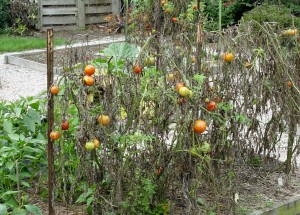Oh, the Troubles I’ve Seen
August 19th, 2014
First, let me say I’m not complaining. This has been a cheerfully choice growing season, one I’ll take any year.
It’s been pleasant temperature-wise, the rain has spread itself out nicely, and we really haven’t hit any oven-grade, parched, grass-browning, oppressive spells.
That said, I have seen a smattering of setbacks worth sharing in case you’re wondering about them, too.
* Rotting tomatoes. Lots of gardeners have been complaining about their tomatoes rotting on the bottom as they ripen (the tomatoes, not the gardeners). This is called blossom-end rot, and it happens because of inconsistent soil moisture. The previous explanation of a lack of calcium now has been discounted.
The solution is to keep the soil moist, which means insulating the ground with straw or leaf mulch and watering when rain doesn’t do the deed for you.
* Dying tomatoes. More troublesome are the leaf diseases (primarily Septoria leaf spot and early blight) that infect tomato plants from the ground up, eventually killing the whole plant and detracting from fruit flavor in the meantime.
At this point, all you can do is pick off infected leaves and spray the plants with a fungicide every 7 to 10 days to slow the progression. Liquid copper is an organic approach; chlorothalonil is the primary chemical option.
* Impatiens still doomed. That downy mildew water-mold disease that suddenly swooped in and killed everyone’s impatiens 2 years ago is alive and kicking.
Although most gardeners stopped planting impatiens after realizing this is a deadly disease that’s likely here to stay, I’ve seen a few patches that had been doing OK up until late July. That’s when downy mildew usually progresses enough to kill.
Sure enough, patches I saw last week had that tell-tale grayish coating on the leaf undersides and were in the process of melting away.
If you want to grow impatiens, stick with the New Guinea types (Divine™ and Florific™ are two less-expensive seed-grown types) or mildew-resistant hybrids such as SunPatiens®.
* Brown patch in the lawn. This cleverly named disease causes brown patches in the lawn, and I’ve seen a fair number of cases that people are mistakenly chalking up to grub damage.
Brown patch is a fungal problem that shows up as blotches that can stretch up to 2 to 3 feet across. Excess fertilizer and frequent wetting of the blades (either from a lot of rain or regular irrigation) encourage it.
Fungicides slow it if you have low tolerance for trouble. Otherwise, it’ll stop with cooler, drier weather. Then reseed any dead patches in September.
* Grubs. OK, grubs really are causing some damage, although I’m not sure this is going to be a bad year for them since I really didn’t see a whole of Japanese beetles. (Grubs are the larval stage of beetles.)
Grub damage is distinctive because brown patches pull up like rootless pieces of carpet. The pinky-sized, C-shaped, fat wormy grubs can be seen in the soil underneath.
Take the smash-and-reseed approach if you’re organic, or look for a product that kills grubs (Dylox or Sevin) if you’re not.
* Dead marigolds. I ran into a home garden last week where a whole patch of normally bullet-proof marigolds were browned and dead.
I was bewildered at first (nothing unusual there) until I found out that the plants had been sprayed with a rabbit repellent. That can do it.
Repellents usually have oils in them that can harm plant foliage, especially if they’re applied on a hot, sunny day. These are best applied on the ground around plants, or at the least, after first spraying a small patch of foliage to make sure they’re not going to do leaf harm. Always read the label for application warnings.
* Black fly update. Get used to those annoying black flies (a.k.a. “gnats”) flying around your face.
They’ve been unusually bad this season due to a combination of funding deficits and frequent rain. The state’s local spraying coordinator told me last week that the budget is completely shot for the year, so no more Bt (Bacillus thuringiensis) controls are on the way.
Get out the Vicks VapoRub or whatever you use to repel these gardener pests until the cold kills them.
* Premature mums. Although the cold winter and cool spring set back the growing season by 2 to 3 weeks, the cool summer apparently has faked mums into thinking it’s almost fall.
Not only are many garden-planted mums already coloring, but growers say their greenhouse-grown mums are also blooming ahead of schedule. That means many of them will be hitting peak form before the bulk of home gardeners are ready to fall-shop for them.
* Perennial crowding. The summer’s conducive weather has been great for perennial growth, and that’s resulted in some gardens that are now looking overgrown.
Go ahead and snip back overly long growth on plants that have finished blooming. Then plan to dig and divide perennials that have grown beyond their bounds.
Early fall is a good time to divide spring and summer bloomers, while early next spring is prime time to divide fall bloomers (and summer bloomers if you don’t get to it in the fall).
* Dump the dead wood. I think you can finally give up now on woody growth that hasn’t leafed out from the killer winter.
I’m still seeing lots of dead branches sticking up from hydrangeas, crape myrtles and such that died back to the ground but sent up new growth from the base. Keep the new growth, but go ahead and cut off wood that’s bare.








